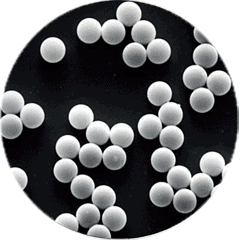What is the principle of magnetic bead method for nucleic acid extraction
With the rapid development of genetic diagnosis, genetically modified food detection, personalized medicine, etc., the current nucleic acid extraction technology can no longer meet the needs of today’s biotechnology, and there is an urgent need for a high-throughput and automated nucleic acid extraction method. In this context, the magnetic bead method for nucleic acid extraction came into being.
The use of magnetic beads for DNA extraction is one of the areas where their biological value is maximized. The main types of microspheres used include silanol magnetic beads and oligo magnetic beads. Magnetic beads with surface groups can specifically and reversibly bind to nucleic acids released in the test sample. At the same time, the magnetic response capability of the magnetic beads is used to carry out directional movement and enrichment under the action of an external magnetic field, so as to realize the separation and purification of nucleic acid. The main advantages of the magnetic bead method for nucleic acid extraction include simple and automated operation, large-scale operation, and short time.
1. What is a magnetic bead
Magnetic beads are a kind of special nano-micron materials. Their size is usually between a few tenths of a few microns to a few microns, which is only one tenth to one tenth of the diameter of a human hair, which cannot be observed by the naked eye. Single magnetic bead. They are superparamagnetic, they can move quickly to one side in a magnetic field, gather together, and can quickly return to a dispersed state after removing the magnetic field.
The surface of the magnetic beads used for nucleic acid extraction has specific properties. Under certain conditions, the viral nucleic acid can be adsorbed on the surface, and under other conditions, the viral nucleic acid can be released from the surface for subsequent detection steps.

2.The principle of magnetic bead method of nucleic acid extraction
The binding of nucleic acid to magnetic beads mainly relies on electrostatic, hydrophobic and hydrogen bonding. The DNA/RNA in the cell or tissue is released under the action of the lysis solution. At this time, the surface-modified superparamagnetic silica nanomagnetic beads “specifically bind” with nucleic acid to form a “nucleic acid-magnetic bead complex”. Then under the action of an external magnetic field, the complex is separated. After the eluate is washed to remove the non-specifically adsorbed magazines, desalted, and purified, the nucleic acid substance to be extracted is obtained.
The nucleic acid extraction principle is according to surface of superparamagnetic nanoparticles is modified and modified by nanotechnology to prepare superparamagnetic silica nanomagnetic beads. The magnetic beads can specifically recognize and efficiently bind with nucleic acid molecules on the microscopic interface. Using the superparamagnetism of silica nanospheres, under the action of Chaotropic salts (guanidine hydrochloride, guanidine isothiocyanate, etc.) and an external magnetic field, DNA and DNA can be separated from samples such as blood, animal tissues, food, and pathogenic microorganisms. RNA can be used in clinical disease diagnosis, blood transfusion safety, forensic identification, environmental microbiological testing, food safety testing, molecular biology research and other fields.
In fact, since testing institutions need to process a large number of samples every day, most of the nucleic acid extraction steps are carried out by means of an automatic nucleic acid extraction instrument with a magnetic bead method nucleic acid extraction kit.



